A fire in Sacramento, California, destroys 75 percent of the city – 2,500 buildings.
Donner Party Hero
They came to California with great hope for the future-they left a legacy.
Enter to win a copy of
With Great Hope: Women of the California Gold Rush.
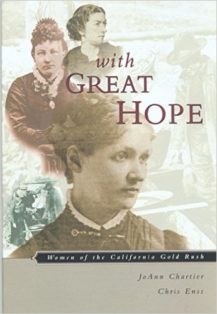
The discovery of gold at Sutter’s Mill, California, in 1848 set off a siren call that many Americans couldn’t resist. Enthusiastic pioneers headed west intent on picking up a fortune in the nearest stream. Though only a few actually used a pickax in the search for a fortune, women played a major role in the California Gold Rush. They discovered wealth working as cooks, writers, photographers, performers, or lobbyists. Some even realized dreams greater than gold in the western land of opportunity and others experienced unspeakable tragedy.
If Mary Graves had stayed in Indiana where she was born on November 1, 1826, she might have married the boy next door, taught students to read and write at a school house in her hometown, and lived out her days watching her children and grandchildren grow up on the family farm. Her life, however, took a different course when her family joined the Donner Party in 1846 and headed west.
Mary was nineteen when her father, Franklin, made the decision to move his family to California. The wagon train the Graves joined was organized by George and Jacob Donner and James Reed and their families. The initial group set out from Springfield, Illinois in April and was joined by additional members when it reached Independence, Missouri. Franklin and Elizabeth Graves and their nine children joined the Donner Party in August at Fort Bridger, Wyoming, with their belongings piled in three large wagons.
Mary was excited about the journey. She had no doubt heard stories of the golden land of opportunity and couldn’t wait to see its riches for herself. She knew her family might experience difficulties getting there but that had not put a damper on her gleeful spirit. She didn’t care that the trail was treacherous, and she wasn’t afraid of the Indians that guarded the way. She placed all her faith in God and her father to get her and her family to their new home safely.
Historical records note that Mary was a beautiful young lady with dark eyes and long, wavy black hair. She carried her slender, five-foot, seven-inch frame with grace. Her complexion was creamy olive. She captured the attention of many of the twenty-two single men in the party, but she was engaged to John Synder, the driver of one of her father’s teams.
On October 5, 1846, John Synder and Milton Elliott, another driver exchanged heated words over whose team of oxen could pull a load raced each other to the top of the hill. John’s and Milton’s teams got tangled up as they raced each other to the top of the hill. John was furious and started cussing at Milton and beating his livestock with a whip-stock. James Reed stepped in and tried to calm him down. John thought James was threatening him, and he jumped off his wagon and beat James over the head with the butt end of his heavy whip-stock while Mary looked on. When James Reed managed to stand up and wipe the blood from his eyes, his wife ran over to help him, and John hit her over the head too. James quickly pulled out a knife and stabbed John. Mary’s intended died fifteen minutes later. The stunned onlookers were outraged. They wanted to hang James. Mary was asked to sit in judgment of him, but she refused. James was banished from the group.
The gleam in Mary’s eyes had started to fade. The journey west was grueling. In addition to having battled the heat and rough terrain, the party had taken a “shortcut” to California that actually took them several hundred miles out of their way. Lack of water and a variety of petty arguments, like the one between John, Milton, and James, created strife among the party members. Their food was running low and many of their oxen and horses had been stolen by Indians.
Mary and the others finally reached the Sierra Nevada mountains on October 28th, 1856.
To learn more about Mary Graves and the other women who came to the Gold Country with great hope read
With Great Hope: Women of the California Gold Rush.
This Day…
Ma Barker’s Last Day
Ma Barker’s last day. Last chance to enter to win a copy of
Ma Barker: America’s Most Wanted Mother.
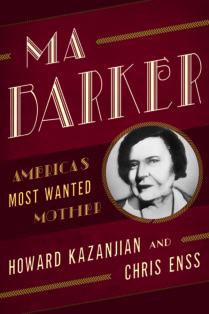
In a time when notorious Depression-era criminals were terrorizing the country, the Barker-Karpis Gang stole more money than mobsters John Dillinger, Vern Miller, and Bonnie and Clyde combined. Five of the most wanted thieves, murderers, and kidnappers by the Federal Bureau of Investigation (FBI) in the 1930s were from the same family. Authorities believed the woman behind the band of violent hoodlums that ravaged the Midwest was their mother, Kate “Ma” Barker.
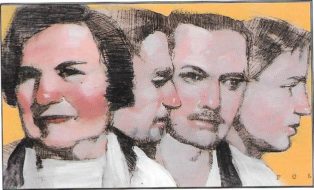
Federal agents shouted to Ma Barker to surrender. The answer came in renewed flashes of fire, shooting from first one window, then another. Occasionally law enforcement officials could see Ma’s gray head or Fred’s dark, red hair as they darted like phantoms across the corner of a window. Hours passed and the fight continued with intermittent bursts of shooting. News of the battle had spread throughout the surrounding country; crowds were arriving, but they kept well back from the line of fire.
It was just before noon when the fusillade died out. Agents carefully inched their way out of their hiding spots and rushed toward the house. They lobbed tear-gas shells into the upstairs windows and waited for it to take effect. Federal authorities sent Willie Woodbury into the house to find out if anyone inside was alive. Agents reasoned the Barkers wouldn’t shoot the loyal servant. Willie entered through the back door moving slowly and cautiously. A minute later, he stuck his head out the upstairs window, coughing and wiping his eyes. The tear-gas fumes were overwhelming. “They are all dead,” he called out to the investigators below. An armed agent hurried into the building to confirm Willie’s findings. It was true. The Barkers were dead.
Ma Barker and Fred were found lying side by side. Her arm was around her youngest boy, his blood staining her breast. Eleven machine-gun slugs were taken from Fred’s corpse, but one shot in the head had killed Ma. Her pudgy hands clasped an empty machine gun. According to the FBI report, a .45 caliber automatic pistol was found near Fred’s body. The report also said:
There was also found in the house a letter signed by B. L. Barnes which was a letter to Fred Barker from his brother Arthur. The letter read as follows: “Hello ever [sic] one how is that old sunshine down there fine I hope. Boy it is not so hot up here, for we are having some winter. I Bet you and Buff are not catching no fish now for I think I caught them all when I was down there. I took care of that Business for you Boys it was done. Just as good as if you had did it yourself. I am Just like the standard oil always at your service ha ha. Tell, Bo, you know the Boy with the rosey [sic] cheek that Moxey is up here looking for him and if it is alright to send him down. I have not seen c_ _ _k yet I have Been Busy on that other he was perrty [sic] hard to locate. But will see him right away, and see if he wants come down there. Tell mother that deer was mighty fine and I said hello and her and the squaw had better not let you Bums Beat them in a catching fish ha ha well I will close for this time as ever you [sic] Big Bud. B. L. Barnes.”
To learn more about Ma Barker and he Barker Gang read
Ma Barker: America’s Most Wanted Mother.
This Day…
1881 – The “Gunfight at the OK Corral” took place in Tombstone, AZ. The fight was between Wyatt Earp, his two brothers and Doc Holiday and the Ike Clanton Gang.
The Bad Mother’s Handbook
Ma’s days are numbered. Enter now to win a copy of
Ma Barker: America’s Most Wanted Mother.
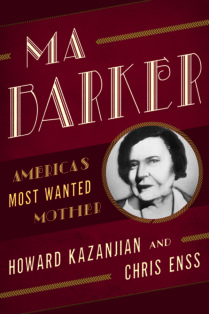
In a time when notorious Depression-era criminals were terrorizing the country, the Barker-Karpis Gang stole more money than mobsters John Dillinger, Vern Miller, and Bonnie and Clyde combined. Five of the most wanted thieves, murderers, and kidnappers by the Federal Bureau of Investigation (FBI) in the 1930s were from the same family. Authorities believed the woman behind the band of violent hoodlums that ravaged the Midwest was their mother, Kate “Ma” Barker.

Ma Barker removed a tattered handkerchief from the navy blue pocketbook cradled in her lap and dabbed away a fake tear. The guards on duty at the Oklahoma Prison were disinterested in her supposed grief. Their job was to make sure the inmates at the facility moved efficiently from the visitor’s area back to their cells. Ma watched a pale-faced, stupefied guard escort her son Arthur out the room. It was mid-February 1920, and mother and son had concluded a short visit. A thick, long glass separated the convicts from the civilized world. Here, communication was done using plain, black phones minus a dial wheel, wired from one side of the glass to the other. Arthur and Ma each had their own receiver to talk through as did several other family and friends visiting their loved ones through the glass partition.
The iron-barred doors clanged shut as the last prisoner was ushered out the room. Ma sat stock-still until she heard the guard lock the door behind the inmates. As she turned to get up from her assigned seat, a heavyset guard approached her, and with flinty eyes, looked her up and down. She looked more frumpy than menacing. The coat she wore was big and bulky, frayed in spots, and a few buttons were missing. The tan, bell-shaped hat on her head had seen better days, and her hair underneath it was pinned back in a haphazard fashion. “My boys would be all right if the law would leave them alone,” she told the guard. He had no response and simply led her to the exit of the room, and she shuffled along as little old ladies do.
Two short siren blasts issued from the main building of the jail as Ma exited the complex. She glanced back at the other visitors following after her and at the stone walls topped with snaky concertina wire overhead. Once every guest had left the jail, the heavy steel doors were closed behind them.
A Cadillac sedan pulled in front of the detention center and stopped. Ma abandoned the old lady gait and hurried to the car as though nothing whatsoever was bothering her physically. She pulled off the old coat she was wearing and draped the fur wrap over her shoulders that one of the passengers inside the car handed her through the window. She opened the passenger’s side door and slid into the seat. The June 19, 1959 edition of the Amarillo Globe Times reported that the Jasper County filing clerk who witnessed Ma Barker leaving the prison saw her removing her hat and straightening her hair as the sedan drove away. “In a few moments she transformed from a somewhat feeble grandmother type to a hearty, rather spirited woman,” the clerk described.
To learn more about Ma Barker and he Barker Gang read
Ma Barker: America’s Most Wanted Mother.
This Day…
Barker Gang Kidnaps Bank President
Ma’s days are numbered. Enter now to win a copy of
Ma Barker: America’s Most Wanted Mother.
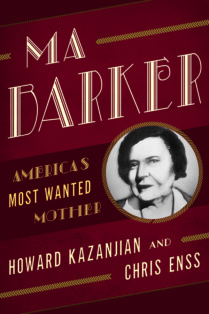
In a time when notorious Depression-era criminals were terrorizing the country, the Barker-Karpis Gang stole more money than mobsters John Dillinger, Vern Miller, and Bonnie and Clyde combined. Five of the most wanted thieves, murderers, and kidnappers by the Federal Bureau of Investigation (FBI) in the 1930s were from the same family. Authorities believed the woman behind the band of violent hoodlums that ravaged the Midwest was their mother, Kate “Ma” Barker.
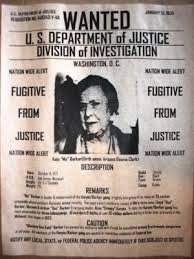
When the suggestion to kidnap Edward Bremer was presented to Ma, she ordered her crew to meet and discuss the proposal. In the summer of 1933, the Barker-Karpis Gang had kidnapped William Hamm, Jr., the president of Hamm’s Brewing Company. The caper was successful, yielding the gang $100,000 in cash for the return of the millionaire. News of the kidnapping was reported throughout the country. “Money or death was the ultimatum laid down by the culprits that absconded with Hamm’s Brewing Company executive,” the June 17, 1933, edition of the Albert Lea Evening Tribune read.
William had been captive near the same location in Bensenville, Illinois, where Edward Bremer was secured away. The police had withdrawn from the case at the request of the family. They were frightened of what might happen to William if law enforcement interfered. The ransom note from the abductors warned the Hamms that William would be shot and killed if the police were allowed any involvement. A note sent to William’s father instructed him to deliver the ransom money in “$5, $10, and $20 bills.” Payment of the ransom for the release of William, the kidnappers directed, was to be made using one of the company’s beer trucks. Not only did the Barker-Karpis Gang get the full amount they were asking in ransom, but when the authorities did begin investigating the kidnapping, a rival gang was arrested for the crime.
“J. Edgar Hoover himself announced from Washington that his men had put together a solid case against the Touhy gang,” Alvin Karpis wrote in his memoirs. “The scientific evidence left no doubt at all,” Hoover said, “that the Touhys were behind the kidnapping of William Hamm.”
The ease with which the Barker-Karpis Gang was able to get away with taking William and collecting the ransom was an argument for kidnapping Edward Bremer. In late December 1933, Ma’s boys convened at William Weaver’s apartment in St. Paul to talk through the details of the abduction. Who would trail Edward to learn about his habits, routine, friends, and work associates, who would write the ransom notes, who would deliver those notes to what contact, and when the job would be done were all determined. With the exception of Arthur, whom Ma suggested might have been a little too rough with the victim, everyone performed his duties as planned.
To learn more about Ma Barker and he Barker Gang read
Ma Barker: America’s Most Wanted Mother.
This Day…
Leave No Fingerprints Behind
Enter now to win a copy of
Ma Barker: America’s Most Wanted Mother.

In a time when notorious Depression-era criminals were terrorizing the country, the Barker-Karpis Gang stole more money than mobsters John Dillinger, Vern Miller, and Bonnie and Clyde combined. Five of the most wanted thieves, murderers, and kidnappers by the Federal Bureau of Investigation (FBI) in the 1930s were from the same family. Authorities believed the woman behind the band of violent hoodlums that ravaged the Midwest was their mother, Kate “Ma” Barker.

The heat generated by the kidnapping of bank president Edward Bremer—which resulted in $200,000 in ransom being paid after the wealthy man was released on January 7, 1934—chased the Barkers, or what was left of them, into hiding. Those who stayed in the Chicago area adopted easy disguises. Alvin Karpis and Fred Barker felt it necessary to take more drastic measures as they were too well-known to the FBI. In mid-March 1934, Karpis—nicknamed “Old Creepy” because of his expressionless eyes—and Fred Barker went to the secluded office of Doctor Joseph Moran to have their fingerprints altered and faces changed.
Doctor Moran had a respectable practice until he started drinking heavily, became an abortionist, and was eventually sent to Joliet prison. When paroled, Moran was hired as a physician for the Chicago Chauffeurs’ Teamsters’ and Helpers Union and set up practice in a hotel, where he led a double life, treating gangsters as well as ordinary patients.
The night he operated on Alvin and Fred he was a physical ruin. His fumbling fingers did little more than butcher his two patients, who were injected with morphine and sent off to recuperate.
Ma Barker gave them medical attention. Though Alvin was stoical, Fred often screamed from the pain and had to be restrained forcefully. In addition to nursing duties, Ma was completing arrangements with gangster Adelard Cunin, a survivor of the North Side mob in Chicago, to launder the $100,000 the Barker-Karpis Gang received as a ransom for kidnapping W. J. Hamm Jr., the president of Hamm’s Brewery in St. Paul, Minnesota. Adelard had agreed to handle the ransom money from the Bremer kidnapping job as well.
The Chicago branch of the Federal Bureau of Investigation was made the busiest field office in FBI history by the depredations of numerous well-known gangs, the perpetrators of the Kansas City massacre, and the normal flow of investigations. Melvin Purvis, the Special Agent in Charge, was the nominal chief. However, that spring of 1934 the office on the nineteenth floor of the Bangers Building was also the headquarters of a Special Squad which the Director of the FBI, J. Edgar Hoover, supervised personally.
Hoover’s dogged concentration on Midwest crime prompted Ma Barker to advise her sons and their outlaw companions to leave the city. She decided it was too dangerous for any member of the Barker-Karpis Gang, disguised or not, to remain in Chicago. Most of the gang scattered. By January 1935, FBI agents had disposed of Pretty Boy Floyd and John Dillinger’s gangs. Ma’s son Arthur had also been seized by authorities.
To learn more about Ma Barker and he Barker Gang read
Ma Barker: America’s Most Wanted Mother.

